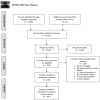Zoonotic Diseases from Horses: A Systematic Review
- PMID: 32077811
- PMCID: PMC7339018
- DOI: 10.1089/vbz.2019.2541
Zoonotic Diseases from Horses: A Systematic Review
Abstract
Background: Worldwide, horses play critical roles in recreation, food production, transportation, and as working animals. Horses' roles differ by geographical region and the socioeconomic status of the people, but despite modern advances in transportation, which have in some ways altered humans contact with horses, potential risks for equine zoonotic pathogen transmission to humans occur globally. While previous reports have focused upon individual or groups of equine pathogens, to our knowledge, a systematic review of equine zoonoses has never been performed. Methods: Using PRISMA's systematic review guidelines, we searched the English literature and identified 233 previous reports of potential equine zoonoses found in horses. We studied and summarized their findings with a goal of identifying risk factors that favor disease transmission from horses to humans. Results: These previous reports identified 56 zoonotic pathogens that have been found in horses. Of the 233 articles, 13 involved direct transmission to humans (5.6%).The main potential routes of transmission included oral, inhalation, and cutaneous exposures. Pathogens most often manifest in humans through systemic, gastrointestinal, and dermatological signs and symptoms. Furthermore, 16.1% were classified as emerging infectious diseases and thus may be less known to both the equine and human medical community. Sometimes, these infections were severe leading to human and equine death. Conclusions: While case reports of zoonotic infections directly from horses remain low, there is a high potential for underreporting due to lack of knowledge among health professionals. Awareness of these zoonotic pathogens, their disease presentation in horses and humans, and their associated risk factors for cross-species infection are important to public health officials, clinicians, and people with recreational or occupational equid exposure.
Keywords: equine; horses; prevention; systematic review; zoonotic diseases.
Conflict of interest statement
No conflicting financial interests exist.
References
-
- Aiello SE, Moses MA, eds. The Merck Veterinary Manual. 11 ed. Whitehouse Station, NJ: Merck & Co., Inc. 2016
-
- Ali-Khan Z. Tissue pathology and comparative microanatomy of Onchocerca from a resident of Ontario and other enzootic Onchocerca species from Canada and the U.S.A. Ann Trop Med Parasitol 1977; 71:469–482 - PubMed
-
- Annand EJ, Reid PA. Clinical review of two fatal equine cases of infection with the insectivorous bat strain of Australian bat lyssavirus. Aust Vet J 2014; 92:324–332 - PubMed
Publication types
MeSH terms
Grants and funding
LinkOut - more resources
Full Text Sources
Medical


